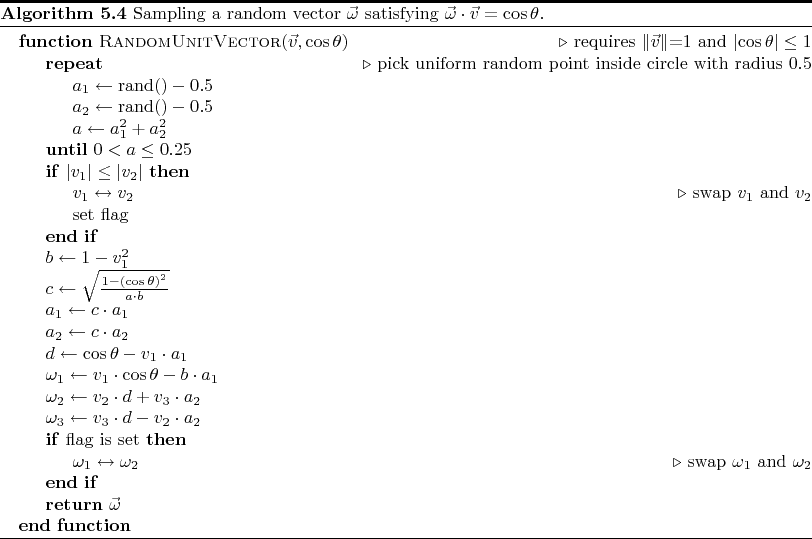



Next: 5.3.4 Cosine Distribution
Up: 5.3 Generation of Random
Previous: 5.3.2 Coned Cosine Distribution
5.3.3 Direction Vector Calculation
Ray tracing usually requires a normalized direction vector. Therefore, once random polar and azimuthal angles with respect to the given unit vector  are determined, the direction vector
are determined, the direction vector
 can be obtained by
can be obtained by
 |
(5.49) |
where
 is a normal vector with respect to
is a normal vector with respect to  , thus satisfying
, thus satisfying
 . The rotational symmetry of the random direction distribution allows an arbitrary choice of
. The rotational symmetry of the random direction distribution allows an arbitrary choice of
 , which can be defined as follows
, which can be defined as follows
 |
(5.50) |
The case differentiation avoids problematic cases, where
 vanishes. In the following, only the first case is considered. The second case can be converted to the first case by exchanging the first two components of
vanishes. In the following, only the first case is considered. The second case can be converted to the first case by exchanging the first two components of  ,
,  and
and  , before calculating
, before calculating
 . A final exchange of the corresponding components of
. A final exchange of the corresponding components of
 ,
,
 and
and
 , leads to the correct direction vector.
, leads to the correct direction vector.
The condition
 together with
together with
 implies
implies
 and
and
 . Therefore,
. Therefore,
 is always well-defined. Insertion into (5.49) gives
is always well-defined. Insertion into (5.49) gives
with
 . Using the second notation of
. Using the second notation of  ,
,
 can be calculated without knowledge of
can be calculated without knowledge of
 at the expense of one additional multiplication. Some distributions, such as the previously discussed power cosine distribution, enable the direct calculation of
at the expense of one additional multiplication. Some distributions, such as the previously discussed power cosine distribution, enable the direct calculation of
 , avoiding the costly evaluation of trigonometric functions for the polar angle entirely (see the last note in Algorithm 5.2).
, avoiding the costly evaluation of trigonometric functions for the polar angle entirely (see the last note in Algorithm 5.2).
The evaluation of the other trigonometric functions in (5.51) can also be avoided. The point
 is uniformly distributed on the unit circle. An alternative way for picking a point on the unit circle is to randomly choose a point
is uniformly distributed on the unit circle. An alternative way for picking a point on the unit circle is to randomly choose a point  on a disk and to calculate the normalized vector
on a disk and to calculate the normalized vector
 [25]. The radicand can be combined with that for the calculation of
[25]. The radicand can be combined with that for the calculation of  obviating the extra evaluation of the root. Algorithm 5.4 describes the determination of a random unit vector
obviating the extra evaluation of the root. Algorithm 5.4 describes the determination of a random unit vector
 around
around  with given polar angle
with given polar angle  , which is equivalent to
, which is equivalent to
 .
.





Next: 5.3.4 Cosine Distribution
Up: 5.3 Generation of Random
Previous: 5.3.2 Coned Cosine Distribution
Otmar Ertl: Numerical Methods for Topography Simulation
![]() together with
together with
![]() implies
implies
![]() and
and
![]() . Therefore,
. Therefore,
![]() is always well-defined. Insertion into (5.49) gives
is always well-defined. Insertion into (5.49) gives
 . Using the second notation of
. Using the second notation of ![]() is uniformly distributed on the unit circle. An alternative way for picking a point on the unit circle is to randomly choose a point
is uniformly distributed on the unit circle. An alternative way for picking a point on the unit circle is to randomly choose a point ![]() on a disk and to calculate the normalized vector
on a disk and to calculate the normalized vector
![]() [25]. The radicand can be combined with that for the calculation of
[25]. The radicand can be combined with that for the calculation of ![]() obviating the extra evaluation of the root. Algorithm 5.4 describes the determination of a random unit vector
obviating the extra evaluation of the root. Algorithm 5.4 describes the determination of a random unit vector
![]() around
around ![]() with given polar angle
with given polar angle ![]() , which is equivalent to
, which is equivalent to
![]() .
.